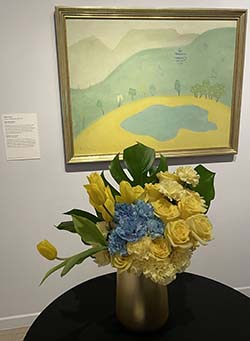
 SAN DIEGO – The Annual Art Alive event at the Museum of Art Sunday morning was accompanied by on and off again showers, proving the saying “April showers bring May flowers.”
SAN DIEGO – The Annual Art Alive event at the Museum of Art Sunday morning was accompanied by on and off again showers, proving the saying “April showers bring May flowers.”
The museum transforms into a botanical and floral delight with activities, special exhibitions, and art installations that make this one of the city’s most anticipated annual events.
The San Diego Museum of Art comes to life with nearly one hundred floral arrangements complementing the Museum’s permanent art collection. Many of the floral arrangements are by local and national floral designers who creatively fill the galleries with many varieties of color and scents. Since the floral arrangements are fragile when cut and used, it is only for one weekend, usually the last weekend in April.
In the Art of the Americas, a piece that stood out to me was Pool in the Mountains, 1950, an oil painting on canvas by American artist Milton Avery. He plays with the perspective of the landscape, so that it has a disproportionate relationship to the luminosity of the pool and its surroundings. The year Avery created this painting, he spent the summer with his family in Woodstock, New York. This painting was created before the landmark three-day music festival in 1969. This area of farm towns in New York’s “Catskills” is where many Jewish families would spend their summers on vacation.
The floral interpretation of Avery’s painting was made by Susan and Michael Gable. It was mentioned that the Gables made this a family project with help from the floral trade center in Carlsbad.
Becky Guttin’s 1999 Strati 2 was on display in the Art of the Americas. In this piece of work, San Diego-based Jewish artist Guttin recovers traditional ways of life still found in villages around Mexico. Based on her childhood memories, her sculptural installation is composed of bronze cases of luffa plants, a type of gourd that can be used as a sponge once dried. The gourds were sliced and reassembled to create abstract forms that interact with light and the surrounding space.
The floral interpretation of Guttin’s sculpture was made by Yumi Rakers. It was mentioned that Rakers was inspired by the abstract art featuring organic shapes and bronze elements. She was also drawn to the use of monotone colors.
Diego Rivera’s, The Hands of Dr. Moore, 1940 oil on canvas painting was on display in the Art of the Americas. The painting’s inscription reads in part, “These are the hands of Dr. Clarence Moore of Los Angeles, California. They trim the tree of life so that it is renewed and does not die.” Teeming with symbolic imagery and reference to roots, female anatomy, and blood, and embellished with the ribbon-like banner below, the painting recalls the work and life of Frida Kahlo, Rivera’s partner. Rivera was from a converso family (forced to convert from Judaism to Catholicism). Many of his paintings have Jewish undertones. Although not raised Jewish, he felt it to be a dominant element in his life.
The German Expressionism gallery includes an oil on canvas painting by Max Beckmann, Moon Landscape, 1925. Beckmann lived in Frankfurt from 1917. The painting depicts a view of the River Main and the Dreikonigskirche (Three Kings Church), which the artist regularly viewed as he returned to the city from his studio every evening. In 1937, Beckmann escaped Nazi Germany initially for Amsterdam, and then the United States where he taught in St. Louis and New York. Although, not a Jewish artist, Beckmann and many Modern Artists were labeled “cultural Bolshevicks” and their paintings were destroyed under the Nazi regime. He fled Germany so he could continue his passion of painting and teaching.
Art Alive is the Museum of Art’s signature fundraiser which provides critical financial support for public programs, education, community outreach, and exhibitions throughout the year. Click here to learn more and click here to donate.
*
Cailin Acosta is the assistant editor of the San Diego Jewish World.